

Winter backpacking is very different from three-season backpacking. It requires more gear, good decision-making, and many new skills. It’s almost like backpacking on a different planet because so many things you take for granted during the rest of the year are different.
For example, you need to melt snow to make drinking water and to keep your boots in your sleeping bag at night so they don’t freeze. You need extra flotation so you don’t sink into the snow and extra traction to avoid sliding on icy surfaces. You have to use special stoves and fuel for cooking that you don’t use the rest of the year, and the list goes on.
One of the best ways to understand the differences between winter and three-season backpacking is to look at the differences in the kind of gear you need to carry. I’ve done this in the form of an annotated gear list below, organized around the core activities that make up a winter backpacking trip. There’s a lot of information packed into this post about winter backpacking activities, gear requirements, and alternatives that I think you’ll find useful if this is new to you.
If you have questions, ask them in the comments. I’m happy to respond.
This winter backpacking gear list is designed for use in temperatures down to zero degrees Fahrenheit for camping in protected campsites. At just under 27 pounds, without food, fuel, or water, it’s a good example of a lightweight winter backpacking gear list and the tradeoffs that you can make to reduce the weight of your winter gear without skimping on comfort or taking too many risks. For colder temperatures, you’d want to bring a heavier sleeping bag and a warmer mid-layer garment.
I’ve broken the gear list into the following sections:
You don’t want to dress too warmly for winter hiking. You’ll be carrying a much heavier pack than in summer, wearing heavier boots, and possibly snowshoes or crampons. Sweat is bad because it will accumulate in your clothes and cool you whenever you stop moving. This can snowball in crappy conditions and lead to hypothermia. If you start to sweat, strip off layers or slow down so your body generates less heat.
| name | description | weight/oz. |
|---|---|---|
| Baffin Borealis Boots | Lightweight double Insulated Boot | 48 |
| Darn Tough Hiker Socks | Cushioned | 2.4 |
| Patagonia Capilene LW Cool LS Jersey | Lightweight | 6.7 |
| Mountain Hardware Fleece Hat | Light enough for exertion | 0.8 |
| Possumdown Gloves | Highly breathable | 1.5 |
| Ragged Mountain 1/2 Zip Intervale Fleece Hoodie | High collar, warm when wet, hood for extra warmth | 10.9 |
| Ragged Mountain Interval Uncoated Gaiters | Highly breathable high gaiters | 4.3 |
| REI Activator 3.0 Softshell Pants | Breathable, stretchy | 15.5 |
| Under Armor Boxers | Non-chafing, some insulation | 3.2 |
It’s not unusual for me to backpack stripped down to my baselayer shirt, especially when hiking uphill. Normally, I can usually get by with a fleece hoody for top insulation when hiking or snowshoeing, but I’ll layer up with a shell if the wind picks up. Down under, I rarely wear long johns under my softshell pants because I get too hot when we’re moving. It has to get really cold and windy for me to layer rain pants over them.
My Baffin Borealis winter backpacking boots require some explanation. Called double insulated boots, they have removable liners. This is desirable in winter so you can sleep with your liners in your sleeping bag and not your entire boots. You do this to prevent the liners from freezing at night using your body heat. These Baffin Borealis boots are a real find because they’re super lightweight and you can walk easily in them. If your winter boots don’t have removable liners, you should be prepared to sleep with them in your sleeping bag.
Another alternative is to wear a vapor barrier liner or a plastic bag (Vapor Barrier Socks Using Reynolds Oven Bags) in a single layer boot, but you still may need to sleep with your boots if the liner leaks perspiration.

External temperatures or wind chill can vary widely on a winter backpacking trip, depending on the time of day, your location, and the amount of surrounding vegetation. It’s best to carry additional layers that you hold in reserve so you can layer up or off as conditions change. This is normal on winter hikes and backpacking trips, with people calling for layer breaks all the time.
| name | description | weight/oz. |
|---|---|---|
| OR Versaliner Sensor Gloves | Wind shell exterior, soft shell glove | 2.8 |
| Enlightened Equipment Visp Rain Pants | Very lightweight | 4.2 |
| Marmot Softshell Gloves | Dries fast | 2 |
| Outdoor Research Cornice Mittens | Waterproof shell mitts, limited dexterity w/Primaloft inner insulated gloves | 8.4 |
| REI Drypoint GTX Jacket | W/B Shell with adjustable hood, hipbelt compatible pockets | 12.0 |
| Sunglasses + Case | Glare protection | 4.2 |
Your extra layers should be easy to put on or take off and they should be packed where they’re easy to access in your backpack. This includes extra hats, extra gloves, jackets, pants, a buff (neck gaiter), sunglasses, or goggles. If you wear big boots, bring rain pants than you can put on or take off without taking your boots off – usually pants with full or 3/4 side zips. My boots are small enough that I can put them on with just boot zip rain pants.
It will be rare for you to need your camping clothes during the day, with the exception of your big puffy jacket, if you stop for a snack or water break. But you have those warm extra layers in reserve if you need them.
My REI Drypoint GTX raincoat/winter shell deserves a little explanation. Other than the fact that it has a fully adjustable hood and velcro wrist cuffs, it’s nothing special. I use it mainly to block the wind. It’s much thicker and heavier than an ultralightweight 3-season raincoat like my Montbell Versalite Jacket, which is a little too cold to use in winter. I bought the Drypoint on the cheap, used from REI last year, for bushwhacking (which destroys clothing) and have been using it a lot this winter.
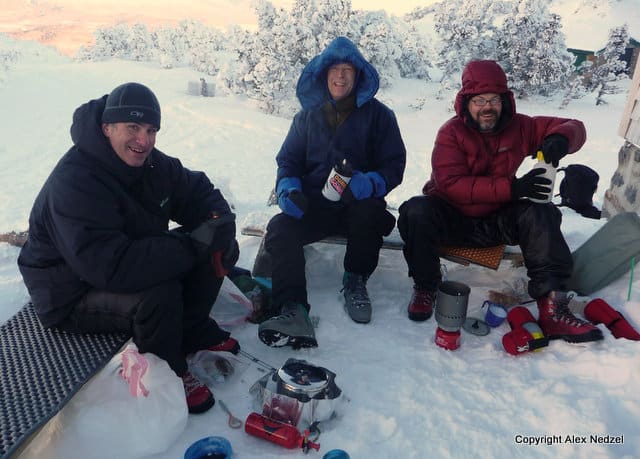
Winter backpacking involves a lot of sitting around in the cold so you can cook and melt snow for drinking water. We do this to be social (because it’s fun) and to avoid dying from carbon monoxide poisoning in our tents or burning them down around us.
| name | description | weight oz. |
|---|---|---|
| Darn Tough Hiker Socks | Wool socks | 2.4 |
| Glasses hard case | Protect glasses when sleeping | 4 |
| Montbell Mirage Parka | Puffy hooded insulation | 14.4 |
| Montbell Thermawrap Pants | Insulated Pants | 12.4 |
| Mountain Hardware Dome Perignon Hat | Really warm hat | 2.1 |
| Terramar Polypro LW Bottoms | Sleeping baselayer | 5.9 |
| Polar Buff | Neck insulation | 2.8 |
| Patagonia Capilene LW Cool LS Jersey | Sleeping baselayer | 6.7 |
When melting snow or cooking dinner, you’re not moving, so you need to pile on the insulated clothing to stay warm. This typically includes a heavily insulated jacket, insulated pants, warm gloves, and head-gear, layered over your day time clothing if it’s dry or your sleeping clothes. You’ll often wear your regular winter boots in camp, but some people bring down booties to keep their feet warm.
Most of these extra “camp” layers are too warm to wear when you’re hiking, but you do need to carry them nonetheless. However, they can be used to augment the warmth of your sleeping bag: I use mine that way so I can take my zero-degree sleeping bag down to -10 degrees. I’m not that interested in camping in anything colder because it’s kind of unpleasant. It took me many years to admit this to myself, but when I did I was able to switch from a -25 degree sleeping bag to a much less expensive and lighter weight, a zero-degree sleeping bag.
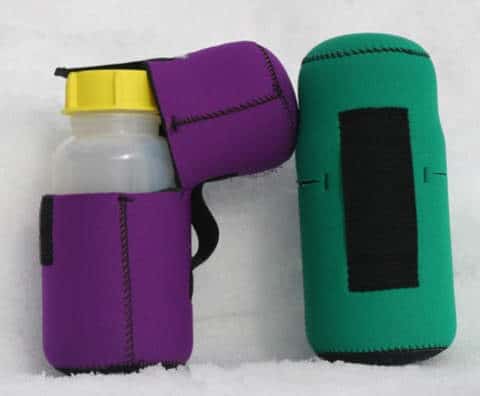
The amount of water you carry on a winter backpacking trip usually varies between two and three liters, so you don’t have to stop and melt more using a stove during the day. You should shoot to have a half-cup of water left at the end of the day as a starter for melting more snow. If you try to melt snow in a dry pot, you’ll burn it and maybe hole your pot.
You’ll want to carry one bottle in an insulated container (foam or neoprene) outside your pack for easy access, positioned upside down so the cap doesn’t freeze. You can store the other bottles inside your backpack, snuggled among your insulating layers in order to save weight on added bottle insulation. You should carry your water in wide-mouth bottles which are less likely to freeze and easier to open if they do. I like to carry soft propylene wide-mouth Hunersdorf bottles in winter, which won’t crack if frozen and are easy to open while wearing mittens. If you can’t find these in stock (they are hard to find in 2020-2021), Nalgene’s White Polyethylene Bottles are also excellent and lighter weight than regular 32 oz transparent Nalgene bottles. You’ll probably want to carry three of them.
| name | description | weight/oz. |
|---|---|---|
| Forty Below Bottle Boots (1 liter) | Neoprene insulated covers for 1 liter bottles | 3.8 |
| Hunersdorf Bottle (1 liter) | Wide mouth bottle | 4.8 |
| Hunersdorf Bottle (1 liter) | Wide mouth bottle | 4.8 |
| Hunersdorf Bottle (1 liter) | Wide mouth bottle | 4.8 |
If you can find water in liquid form, you still have to purify it. Boiling is an effective way to do this since you’ll want to heat it up anyway to keep it from freezing overnight. A Steripen can also be used. Chemical reactions are too slow in the cold and filters break if they freeze.
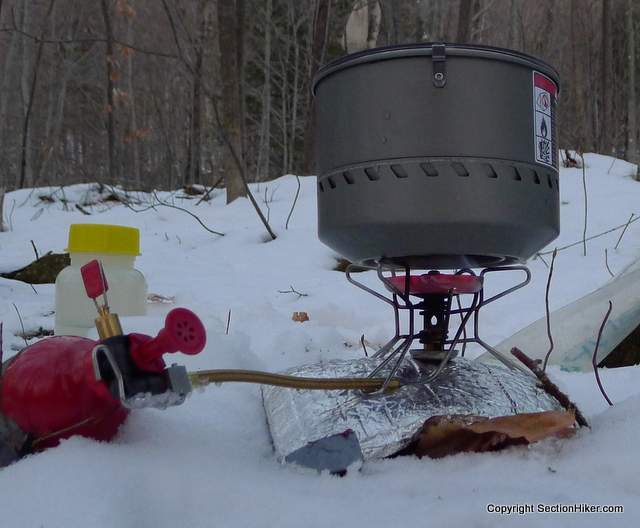
All this boiling and melting snow take a lot of time and stove fuel. I like to use a liquid fuel stove for winter because liquid fuel (white gas) is the highest BTU fuel available and it will burn down to -40F. While you can use a canister stove in winter, it becomes increasingly difficult to use under 20F. You can push that down to about 0 degrees with a special inverted canister stove like the Jetboil Joule. But liquid fuel is still the best all-around solution in my opinion and makes it easy to share fuel in a group since so many other people use liquid fuel stoves in winter. Stoves fail in winter and that extra redundancy is nice.
| name | description | weight/oz. |
|---|---|---|
| Evernew 1.3 L Titanium Pot w/handle | Winter size for melting snow | 4 |
| Light My Fire Fire Steel | Fire starter | 1 |
| Mesh Stuff Sack | Holds winter stove kit together | 0.8 |
| MSR 20 oz Fuel Bottle | 6.3 | |
| MSR Whisperlite | White Gas Stove w/fuel pump | 11.4 |
| Windscreen | Titanium windscreen | 0.5 |
| Aluminum Pie Tin | Makes a great white gas stove stand | 1 |
| OP Sack | Food bag, heavy plastic | 1.3 |
| Sea to Summit Delta Insulated Mug | With cap, liquid measurements | 4 |
| Victorinox Classic Swiss Army Knife | Tiny little knife with scissors | 0.7 |
Packing space is at a real premium in winter, but winter cooking gear can be bulky. With the exception of my fuel bottle and insulated cup, my entire cook system fits in my stove pot, which keeps it nice and compact. At 1.3 liters, the pot is about as small as you can go for melting snow since you can only melt one bottle’s worth at a time.
Navigation needs can vary widely in winter. While a map can suffice if you’re on a well-used trail system and visibility is good, trails become more difficult to find in winter when they’re covered in snow, the horizon is fogged in, or the snow is so deep that the blazes are buried under your feet. I always carry a compass for route finding, but it takes some practice to be able to use it effectively in winter.
I also carry a whistle, something I carry all year, which is good for signaling companions when you can’t see them, like in dense fog or heavy vegetation. A whistle carries farther than the human voice and you can blow on it without becoming exhausted.
| name | description | weight/oz. |
|---|---|---|
| Fox 40 Plastic Whistle | Really loud whistle | 0.1 |
| Suunto M3 Compass | Adjustable declination | 1.5 |
While I do use an iPhone and the GaiaGPS App, amongst others, for GPS navigation during the rest of the year, mostly I just use a map in winter and a compass. If I need it, I have a built-in GPS receiver and USGS maps in the Garmin inReach Explorer+ I carry for emergency use, but most of the time I keep it turned off.
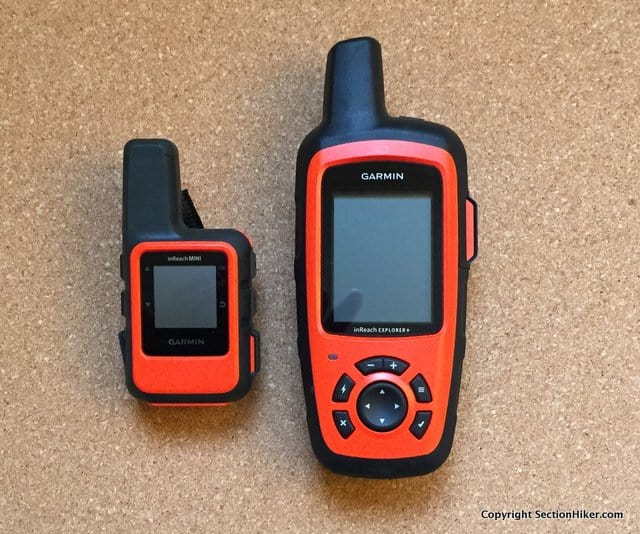
I always bring a digital camera because I take a lot of photos, as well as a Garmin inReach Explorer+. The Explorer lets me send out periodic “OK” messages, which my wife appreciates, and would be useful in an emergency to contact Search and Rescue if I’m out of cellphone range. I like the inReach Explorer+ better than the InReach mini because it’s much easier to use with gloves. That’s important in winter because there are times when you can’t take off your gloves without risking frostbite. I also carry a phone because it’s a better way to contact search-and-rescue if a cell phone signal is available. I also use my phone to read books and to take notes.
| name | description | weight/oz. |
|---|---|---|
| Nitecore NU20 Headlamp | micro-USB Rechargeable | 1.66 |
| Canon G9 MKII Rechargeable Camera | micro-USB Rechargeable | 7.9 |
| iPhone XR | Lightning-USB Rechargeable | 7.9 |
| Garmin inReach Explorer+ | micro-USB Rechargeable | 7.6 |
| Battery Pack and cords | 6.0 |
In the past year, I’ve also replaced my headlamp, camera, and satellite messenger with products that are micro-USB or apple lightning compatible so that I don’t have to carry device-specific batteries for them. I now carry a single 10,000 mAh battery pack and a few short cords so I can recharge them if needed. Standardizing around USB rechargeable devices has simplified my trip preparation and eliminated the need to throw out partially-used batteries after each trip.
I use the exact self-assembled first-aid kit in the winter that I carry the rest of the year. Nothing special: Benedryl, Aspirin, Advil, earplugs, Leuoktape for blister prevention. Some other odds and ends. You can find a complete list of my first aid contents here: Homemade Ultralight First Aid Kit.
| name | description | weight/oz. |
|---|---|---|
| First aid kit | Self assembled | 6.6 |

One of the keys to reducing your winter gear weight is to keep the volume of the backpack you need as small as possible. That means carrying highly compressible gear and learning how to attach gear to the outside of your backpack using its external attachment system. The weight of your gear is important of course, but if you can keep the volume of your pack under 60 liters, you’re going to be way ahead of the game. This may require some compromises on your part, for example, not backpacking when temperatures are less than zero degrees, but you can’t have it both ways.
| name | description | weight/oz. |
|---|---|---|
| Hyperlite Mountain Gear Stuff Sack | Assorted Dyneema DCF stuff sacks | 3.5 |
| Hyperlite Mountain Gear 3400 (55L) Southwest Pack | Dyneema DCF backpack | 32.4 |
| Hyperlite Mountain Gear Shoulder Pocket | Dyneema DCF shoulder strap pocket for camera, phone. | 1.4 |
| Trash compactor bag | waterproof pack liner | 2.0 |
| Mini-biner | Attach swiss army knife to pack | 0.1 |
My winter backpack is a Dyneema DCF Hyperlite Mountain Gear 3400 (55L) Southwest Backpack, the same pack I use for longer multi-day backpacking trips the rest of the year. I can fit all of the gear, food, fuel, and water I need for winter backpacking inside it or attached to the outside of the pack with extra room to spare. I’ve used slightly larger and heavier backpacks in the past, but this one weighs significantly just over two pounds. It opens from the top with a roll-top, which I find useful in winter because I can quickly find the gear I need.
Dyneema backpacks are not waterproof because you need to make holes in the fabric to sew on the shoulder pads and hip belt. I line my pack with a white trash compactor bag to keep its contents dry, and while I use stuff sacks or Ziploc baggies to organize gear, I pack a lot of clothes in my pack loose. I find that this reduces the pack space required by my clothes, eliminating the air gaps between other bulkier items inside my backpack. Experiment with this and see what you prefer.
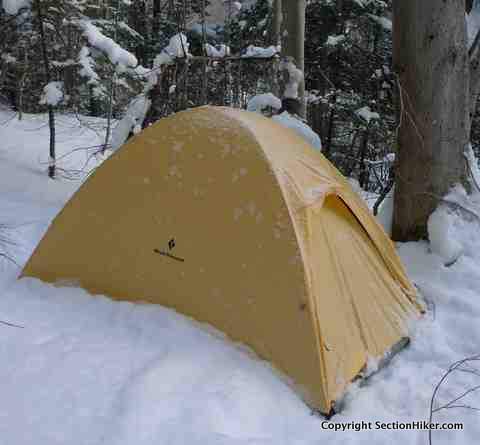
My goto shelter in winter is a freestanding Black Diamond Firstlight Tent which I think is the best lightweight all-round winter backpacking tent made because it’s truly freestanding, making it easy to set up anywhere. It has very steep walls that shed snow well, good headroom, and has plenty of interior space since it’s designed for two (very friendly) people. I have an older model that weighs 43 ounces: the current version weighs in at 48 ounces.
| name | description | weight/oz. |
|---|---|---|
| Black Diamond Firstlight Tent | Freestanding, 4 season tent | 43 |
I don’t carry any tent stakes to pitch this tent. If I need anchors, I take apart my poles and use them as stakes (shown) or anchor the other guy out loops with other gear I carry, like snowshoes, crampons, or an ice ax. I rarely even bother to sinter (harden) the snow under the tent and just set it up. Since it’s freestanding, I can pitch it in less than 2 minutes, climb in, and change into dry clothes without standing around and getting cold. Freestanding tents are priceless in winter but few truly freestanding tents are made.
It’s not unusual to sleep for 12 hours on a winter backpacking trip, so you might as well make the most of it and be comfortable and warm. The key to this is bringing a warm sleeping bag and a thick sleeping pad with a high R-value. Many people like to bring two sleeping pads in winter and combine them to get the R-value (which is additive) that they need.
In 2020, several sleeping pad manufacturers including Therm-a-Rest, Sea-to-Summit, NEMO, and Big Agness rolled out a standard measure of R-values (called ASTM 3340) so you can compare their pads to one another. That standard has not been uniformly adopted by other manufacturers yet so you need to be cautious when comparing the sleeping pad R-values of other manufacturers with each other. Be especially wary of manufacturers who “estimate” the R-value of their sleeping pads. That said, R-values are often the only way to measure the thermal insulation of pads, so they remain useful for guidance.
For winter camping and backpacking, you want an R-value of 5 or 6, so that’s the amount of sleeping pad insulation I shoot for, and experience has proven this out.
| name | description | weight/oz. |
| NEMO Sonic 0 Sleeping Bag | Roomy winter bag | 48 |
| REI Compression Sack | For sleeping bag | 3 |
| Therm-a-Rest Xtherm Sleeping Pad | R value=6.9 | 15 |
| Therm-a-Rest Zlite Sleeping Pad | Doubles as sit pad | 8.1 |
I bring an insulated Therm-a-Rest XTherm inflatable mattress (R-value = 6.9 ) for comfort and a shortened foam Therm-a-Rest Zlite Sol sleeping pad, which serves as my sit pad during dinner when we sit on snow to cook and melt snow for drinking water. You don’t want to forget a sit pad on a winter backpacking trip or you’ll freeze your ass off!
I put the Zlite under the XTherm at night for additional insulation or use it as a doormat that I can kneel on. Foam pads like this are also preferred for shielding accident victims from hypothermia from the ground, which is why you see so many winter day hikers and backpackers carrying them on the trails. It’s good to have at least one in your group.
As I mentioned previously, I downgraded from a -25 degree sleeping bag to a 0-degree sleeping bag, when I realized that I don’t really enjoy backpacking in sub-zero temperatures. It took me a long time to realize this – nearly a decade. But after I switched to a 0-degree bag, I was able to switch to a smaller volume backpack, and so on, shaving more weight from my gear list. I still carry enough extra insulated clothing that I can take my 0-degree bag down to -10, but I’m also likely to postpone a backpacking trip if the weather forecast is that cold at night.
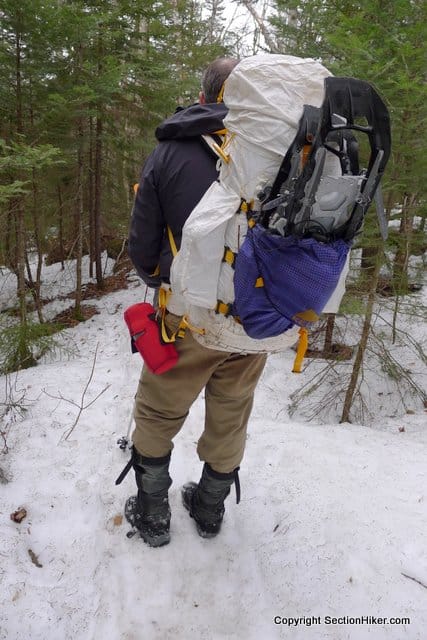
I always bring microspikes, snowshoes, and trekking poles on winter backpacking trips, so they have a permanent spot on my winter gear list. It’s important to replace the summer baskets on your trekking poles with snow baskets for winter travel. They really are an essential flotation aid for winter hiking.
| name | description | weight/oz. |
|---|---|---|
| Hillsound Trail Crampon Ultra | Microspikes | 16.8 |
| MSR Evo Ascent Snowshoes 22 inch | Bomber snowshoe | 64 |
| Pacerpole Dual Lock Poles | Carbon fiber w/snow baskets | 20.8 |
The MSR Evo Ascent Snowshoes I use are intended for climbing mountains and have a televator wire that lifts up under the heel to make them easier to climb slopes with. Their unibody plastic snowshoe is also much better off-trail than a snowshoe with an attached fabric deck because branches can’t become caught between the deck and the frame. I do a lot of off-trail hiking in winter and there’s a slight weight penalty (just a few ounces) for using these snowshoes instead of decked ones that are slightly lighter.
When I don’t need this extra gear, I’ll leave it at home. It consists of extra traction, navigation, and a shovel for digging out camp kitchen or vestibule trenches in deep snow.
| name | description | category | weight/oz. |
|---|---|---|---|
| Hillsound Trail Crampon Pro | ratchet style crampon | traction | 24.9 |
| CAMP Corsa Ice Axe | UL Ice axe | traction | 10 |
| Voile Telepro Avalanche Shovel | for digging snow furniture | shelter | 29 |
| Smith Knowledge OTG Fan Goggles | Internal fan to prevent fogging (hard to find in 2020-2021) mainly for use above treeline | clothing | 6.1 |
| Combo Clava | Face protection above treeline | clothing | 2.4 |
The decision on whether to bring crampons or a GPS has a lot to do with the terrain where we plan to hike, the weather forecast, and trip reports that document local conditions that are posted by other hikers and backpackers.
This 27-pound winter backpacking gear list is pretty streamlined and lightweight and should provide you with a good template of the gear required for winter backpacking and camping. My advice – figure out what is right for you to be safe and comfortable, and suck it up if it weighs a bit more than you’d like. Winter backpacking gear IS heavier than three-season hiking gear, but if you can get your full-out pack weight for a two night trip under 40 pounds, including food, water, and fuel, that’s a good target weight to shoot for.